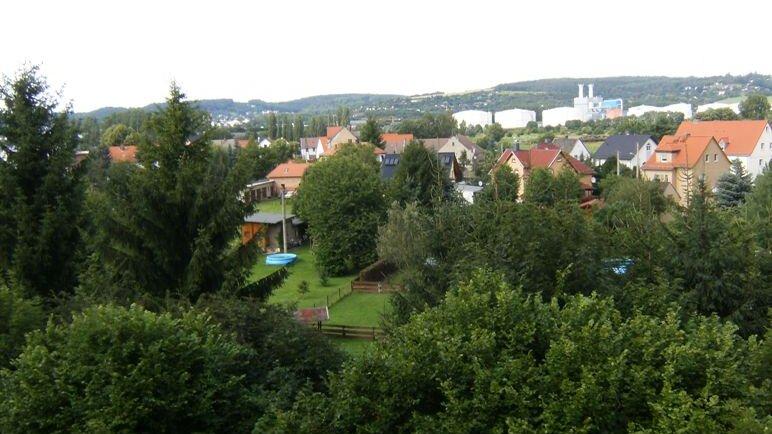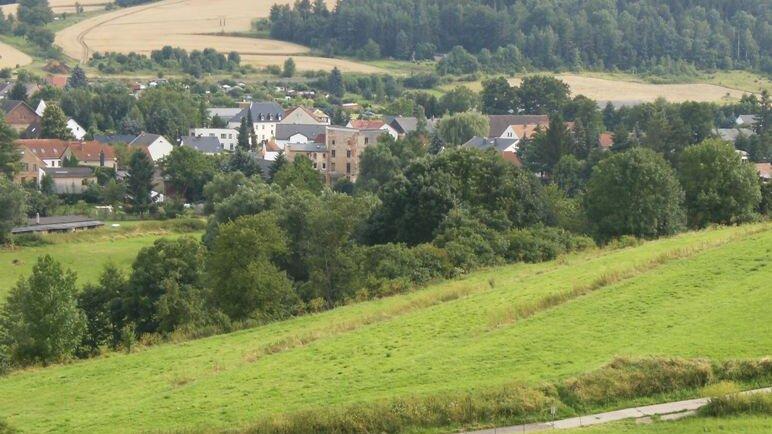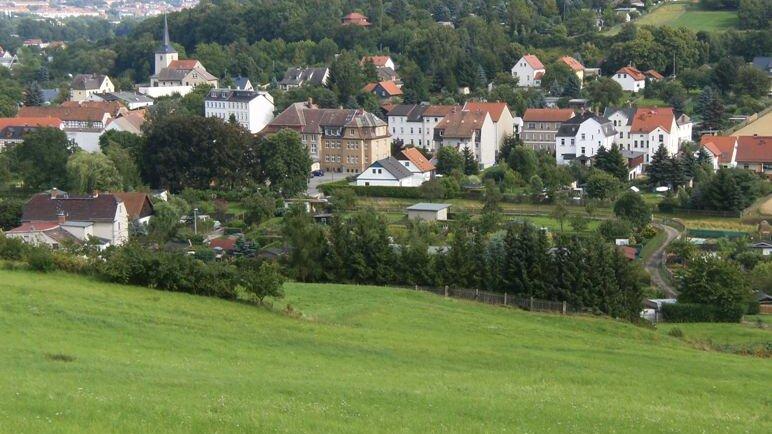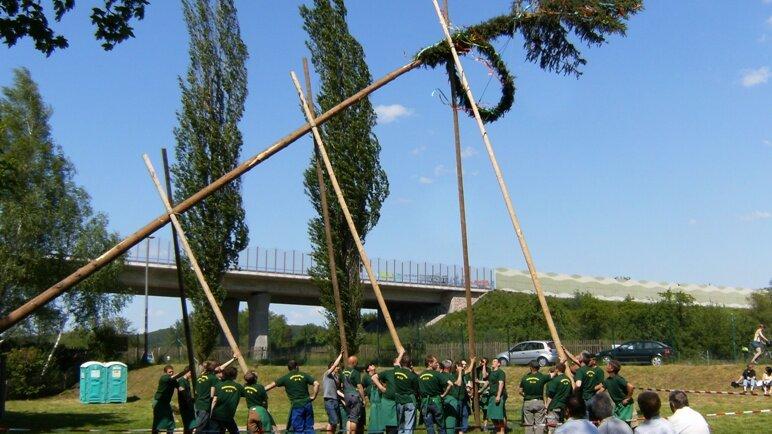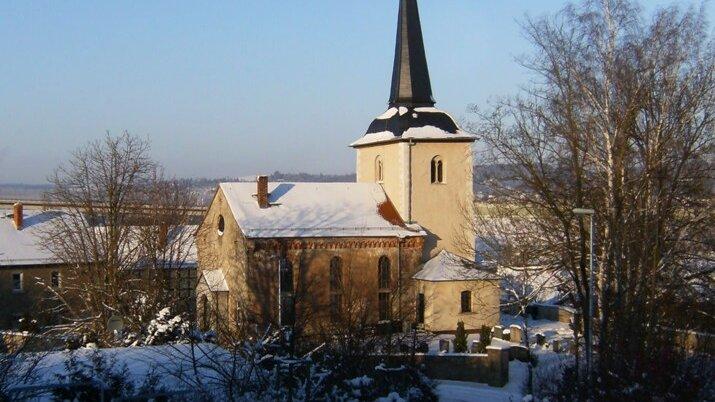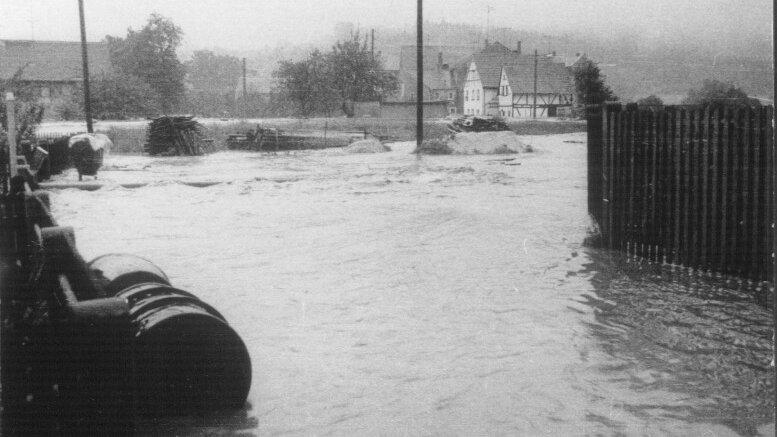District Milbitz / Thieschitz / Rubitz
Data and facts
| Name of the district: | Milbitz / Thieschitz / Rubitz |
| with the localities: | Milbitz, Thieschitz, Rubitz |
| District of the city of Gera since: | 01.01.1919 |
| Surface area: | 530 ha |
| Population: (as at: 31.12.2022) | 671 |
Location and transport connections
| Location: | Milbitz, Thieschitz and Rubitz are located in the western part of the town, directly on the border with the district of Greiz. They are bordered to the south by the Gera/Erfurt railroad line built in 1875 and, since 1938, to the north by the federal highway, in particular the monumental Thieschitz highway viaduct. The slightly undulating plateau is predominantly characterized by agricultural land. Larger contiguous forest areas are located in the northern part and frame the districts from the north and south. |
| Utilization: | The existing, established villages are partly village-like and small-town in character and reflect the historical combination of agricultural and residential use in terms of design. The arable land is farmed by the Reußische Gutsverwaltung. Small craft and service businesses are located here. |
| Landscape and site design: | The landscape is characterized by farmland, meadows and woodland. The integration of the established villages into the landscape is given due to the strong greening with trees and shrubs typical of the landscape. The districts border on the "Geraer Stadtwald" landscape conservation area. There are also orchards and biotopes requiring special protection in accordance with Section 18 ThürNatG. |
School / daycare center / leisure facilities / sights
| Children's facility: | The nearest children's facility is located in the Untermhaus district of Gera. |
| School: | The nearest schools are located in the city of Gera. |
| Children's and youth facilities: | |
| Sports fields / playgrounds / leisure facilities: | Riding stadium in Milbitz |
| Outdoor area at the clubhouse der Maibaumgesellschaft Milbitz-Thieschitz-Rubitz e.V. | |
| Playground in Rubitz | |
| Worth seeing: | Bronzezeitliche Hügelgräber (13 Stück) auf der Cosse (Rubitz) |
| Clubs: | Maibaumgesellschaft Milbitz, Thieschitz, Rubitz e.V. |
| Tierheimförderverein e.V. | |
| Reitverein Gera e.V. | |
| Partnergesellschaft Gera - Fort Wayne e.V. | |
| Church / cemetery: | Protestant church and cemetery in Thieschitz (partly communal) |
History
History Milbitz/Thieschitz/Rubitz
(Author: Mrs. Türpitz (†) Additions by Mr. N. Geißler (mayor of the district)
Milbitz, Thieschitz and Rubitz have belonged to the city since January 1, 1919.
The city council decided to establish them as an independent district in 2001, and the first district council was elected on February 6, 2002.
Sorbian settlers settled west of the Weiße Elster from around the 6th century, establishing the three villages in the typical Sorbian roundel form. However, excavations in the past have shown that the area was settled much earlier. Bronze Age finds were recovered in particular from the 13 mounds in the Cosse (Rubitz) burial site, which are now in the town museum. Numerous bone finds above the Thieschitz church - especially during the construction of the railroad line - point to a Slavic burial ground.
According to legend, dwarves and elves used to haunt the area. The small dwarf cave with the adjoining restaurant of the same name on Untermhäuser Straße still exists today; the dolomite massif with the large dwarf cave on today's Thieschitz - Bad Köstritz road was demolished between 1848 and 1860 as a quarry and a last bastion had to make way for road construction in 1920. The dwarf caves are said to have been the dwelling place of the dwarf king Coryllis and his people, who were there to help and advise the people. Unfortunately, the dwarves had a taste for freshly baked bread and stole some of it, so that the humans resorted to adding caraway, fennel and aniseed to the bread, which did not go down well with the dwarves, who left the inhospitable region in a huff.
During the Thirty Years' War, imperial troops repeatedly marched through the villages, and during the Seven Years' War, Prussian troops were quartered here for months. Napoleonic troops also left their mark: an old municipal account book provides information that on October 11, the French extorted 62 thalers from the municipal treasury with the proviso that the village would be spared, which they did not do: the next day, 100 hussars were in the village and the damage was later estimated at 1,000 thalers. The cost of quartering the French troops in 1812 amounted to 385 thalers and 2 groschen.
Even more tragic than these wars were the two floods in 1954 and on August 10, 1981, which caused devastating damage, especially in Rubitz and Thieschitz.
From the end of the 19th to the middle of the 20th century, the three villages were popular destinations for the Sunday outings of the "Gerschen". Of the once numerous inns, the best known and most popular of which were the Lunapark in Milbitz, Scheffels Gasthof in Thieschitz and the Schützenhaus in Rubitz, none are still open today.
Today, the villages are bordered to the south by the railroad line built in 1875 and, since 1938, to the north by the highway, and here in particular by the rather monumental Thieschitz highway valley bridge, which was renewed in 1997 as part of the expansion of the highway to six lanes.
Milbitz
There are two explanations for the name of the village: the first assumes an origin from Mel (garbage, debris) in the sense of the sediment deposits on the banks of the Elster, the second is the patronymic origin of a Sorbian founder of the village Mil and thus Milvice equals "clan of Mil".
Milwicz is first recorded in a document on November 12, 1322, in which the bailiffs of Gera confirm the purchase of fields from the Kronschwitz monastery. In 1506, Bonifatius von Schaurodt acquired the village for 400 guilders Rhenish. Later, Milbitz became part of the Reuss dominion, became subject to the Reuss court with its then seven farmsteads, and was subject to the Ernsee chamber estate. From 1659, the horse estates in Milbitz were obliged to pay all building fees for Osterstein Castle and the Old Town Castle, as well as all timber transportation for bridge construction and commercial transportation for the Vorwerk and the Untermhaus distillery.
On November 11, 1899, the Milbitz sanatoriums, a foundation of the Gera family Louis Schlutter, were opened in the Am Weinberg district. Expanded in 1927, they served as a military hospital during the Second World War and as a sanatorium for the Soviet occupation after 1945. The district itself was assigned to Untermhaus in the 1970s. Since 1990, the buildings have been left to decay.
The riding stadium in Milbitz is one of the city's most outstanding sports facilities and has already hosted international CHIO tournaments, World Cup show jumping competitions and the German Show Jumping and Dressage Championships. Opened in 1974, the pitches and grandstand facilities were completely renovated in 2000 and a new indoor arena was added.
As a result of the floods in 2013, the equestrian stadium was adapted to the latest flood protection standards with extensive structural measures. This included the demolition of the old riding hall, a new stable and riding hall and the construction of a new riding arena.
Not far away, the Franzosenbrücke bridge, whose current steel structure replaced its wooden predecessor from 1926, leads to the dog sports ground of the now hundred-year-old Verein für Deutsche Schäferhunde, Gera section, as well as the animal shelter of the city of Gera, which rounds off the range of truly animal-friendly facilities in Milbitz.
Thieschitz
The oldest known mention of Thieschitz dates back to September 23, 1540: Heinrich von Eichigkt, lord of the manor of Langenberg, certifies a field and meadow with interest and feud in Teschwitz. The place name also allows several interpretations here: namely from techa (= comfort, pleasure), which indicates the pleasant location of the place, or a derivation from Djasice, place of goblins or dwarves. Thieschitz has been the place of worship for the three communities since the settlers abandoned their pagan beliefs.
The first church was probably built around 1200 and was replaced by a new stone building around 1541 following the reformation of the community in 1533. The church of the parish of Thieschitz received its present form in 1867 through reconstruction and almost complete rebuilding.
Due to the close links between church and school in the past, Thieschitz also developed into the school location for the three villages. An independent school building is mentioned for the first time in 1570, which was replaced by a new building in 1837. This "old school", now a residential building, stands next to the vicarage, while the "new school" in Thieschitzer Straße was inaugurated in 1912. The last school enrolment took place here in 1975, after which the local kindergarten was relocated to the building.
After its closure in 1995, it was acquired by the AMSA Academy for Medical and Social Education in 1996 and established a state-approved higher vocational school for occupational therapy. The assembly hall, which was built in 2002 to replace the old sanitary wing, is also available to the local community on request. After the closure of the higher vocational school, the building was sold. The new owner uses the building as a concert hall after the complete conversion and extension.
A volunteer fire department existed until 2006.
The equipment shed of the volunteer fire department was converted into the clubhouse of the Milbitz-Thieschitz-Rubitz e.V. maypole society.
The supermarket and post office were also closed in the 1990s. Thieschitz railroad station can also only celebrate its "100th" as a kind of retiree: The Gera-Weimar Railway, which had been cutting through the village since 1875, had become usable for the three villages with the opening of the station in 1913, which subsequently made the village attractive as a place of residence for the "Gerschen". Now operated by DB, the last train stopped in Thieschitz in 1996, the station buildings were sold and are now used as residential buildings. The Thieschitz railroad bridge, which had become dilapidated due to the passage of time, was replaced by a new building in 2002/03, which was opened on July 9, 2003.
Rubitz
Rubitz was first mentioned in 1147 as the Roboce fief of the cathedral chapter of Zeitz. In contrast to Milbitz and Thieschitz, Rubitz was a manor for many centuries with changing feudal lords, who were also responsible for the upper and lower jurisdiction, such as von Schauroth, von Uttenhofen and later von Biesenroth. The street Cosse on the north-western edge of the village is still listed as an independent village around 1550.
On May 3, 1681, Katharina Elisabeth Reuß, widow of the Gera sovereign Heinrich II Posthumus Reuß, who died in 1670, acquires the estate for 12,000 guilders. She used the now Prussian chamber estate as a summer and widow's residence and entrusted its management to changing tenants. With the dissolution of the Thuringian petty states, the House of Reuss transferred the estate to the state in 1920. After the Second World War, it was managed as a state-owned estate until the early 1970s.
The Rubitz gymnasium, inaugurated on January 16, 1906, was built by the Rubitz Gymnastics Club, which was founded in 1882. It was also made available to the Thieschitz school for gymnastics. In 1983, after the flood damage had been cleared, an extension with a hall, kitchen and sanitary facilities was built by the residents themselves, which had to be demolished in 2007 due to claims by third parties. The gymnasium currently serves as a commercial building, but was able to enjoy a large celebration - organized by the maypole society - on its 100th birthday. In 2017, master baker M. Möbius opened a seasonal café in the former gymnasium.
The floods on August 10, 1981 caused severe damage to the village: Heavy rainfall, some of which reached 210 liters per square meter around noon, and the railroad bridge near Töppeln, behind which the masses of water had accumulated, broke. Two citizens from Rubitz were caught in the flood and lost their lives. Around 75% of all homes were under water.
Energy, drinking water and telecommunications supplies collapsed completely, and the roads and the course of the Erlbach were severely damaged. Due to the damage to the buildings, three properties had to be demolished and around 30 people had to be provided with new housing.
